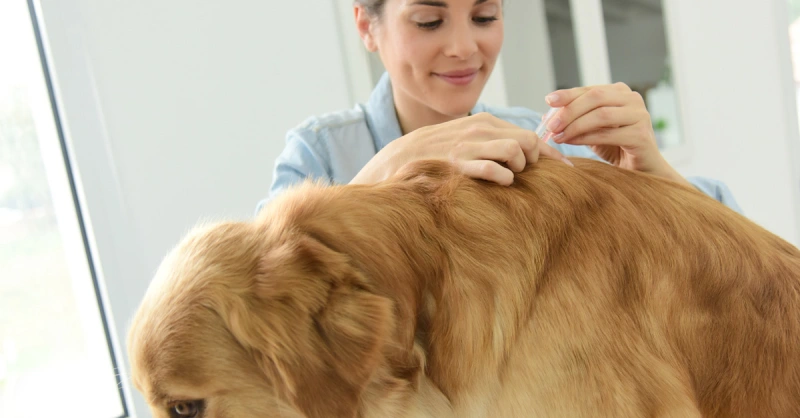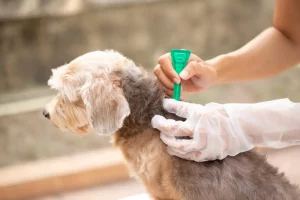
Last Updated on 1 year by Jenny Sovann
Are you looking for ways to control fleas and ticks on your dog? There are uninvited guests that show up on our furry friends that nobody wants in their homes. Fleas and ticks are pesky tiny parasites that can turn your dog into a scratching maniac. It’s nothing to smile about. These parasites make your dog’s life unbearing and constantly uncomfortable. Your dog may end up hurting itself by scratching. After all these parasites cause severe itching and irritation. But worry not. There are several solutions to this problem and in this guide, we will go through how to get rid of fleas and ticks on dogs.
It is important to get rid of these parasites promptly to prevent your furry friend from hurting himself. Let’s get you ready to become a seasoned flea fighter with some effective ways to ensure your furry friend is parasite free. It’s time to get rid of these fleas and ticks to make your dog enjoy taking naps and playing in the sun.
Regular Grooming
Grooming your dog regularly will help in removing fleas and ticks latched onto your furry friend’s coat. It’s an effective way to prevent flea and tick infestation. Brushing your dog’s coat daily while checking for any signs of fleas and ticks will help prevent them from multiplying and spreading fast on your dog’s coat.
Regular grooming would involve the use of a flea comb. This is a comb that has tight teeth to help in removing fleas. Focusing on areas like the neck, behind the ears, and around the tail would yield the best results in finding the annoying little creatures.
On the other hand, using tweezers would help in eradicating any ticks. It is important to put on gloves to prevent yourself from getting tick-borne infections. Take care not to crush the tick, remove the entire tick including its head and mouthparts which tend to stick to the skin.
Ensure that you disinfect bite areas by rubbing alcohol or any other antiseptic. Grooming your dog is the key to preventing these parasites. Remember to brush, bathe, and trim nails and hair. You can consider taking your dog to a professional groomer if all this seems like a difficult task.
Medications
Medications that take care of fleas and ticks come in different forms. The most common types of flea and tick medication are Topical medications, oral medications, or collars. This can be applied on the skin, taken from the mouth, or in collars that release a certain form of repellant. These medications can be prescribed by a veterinarian or offered in shops.
These medications can act as repellants or can kill ticks and fleas. The effectiveness of flea medication varies on the product or the dog. It is important however to follow the medication as directed to ensure that it is indeed effective. If you have any concerns about the treatment or prevention it is important to consult your vet.
As much as the medication will help In treating your furry friend, it’s important to take extra precautions such as regular cleaning and grooming to prevent re-infestations.
Environmental Controls
Medicines worked but that’s not all. Your battle has just begun and you should ensure that you end up winning this war. Ticks and Fleas don’t grow from your dog, they come from your environment and you have to ensure your environment is parasite free. Within your own house, vacuum your floors regularly to remove the surviving parasites. Wash your dog’s bedding and kennel. Ensure fabric items your dog spends time on are spotless. Consider using antiparasitic repellants and foggers in your house.
It’s not over yet, let’s also take precautions outdoors. After all, your playful furry friend probably loves wagging its tail and chasing butterflies out there. Keep your yard mowed because fleas and ticks thrive where the grass is overgrown. That pile of raked leaves, wood, or clutter in your yard makes the perfect home for this little nuisance. Make barriers between your property and other people’s property. It is a pointless effort to prevent something that will be brought back by your careless neighbor.
If you live close to wild animals like rodents such as raccoons, ensure that they stay away from your dog. These animals can carry fleas since they are free spirits and roam around the world picking all kind of bugs and diseases as they go.
Natural Remedies
Sometimes you just want to keep it natural and avoid a lot of chemicals. There are natural remedies to help you fight your fleas and tick infestation. Some of these are oils like cedar, lavender, and eucalyptus that can be mixed with water and applied to your dog’s coat. They can be in form of herbal shampoos which are also effective in repelling fleas and ticks.
Surprisingly, doing something as simple as using lemon and a water mixture can help you repel fleas. This can only work if you do it properly. Fleas don’t do well with citrus and hence this natural remedy can prove effective in fighting this war.
As much as this sounds easy and probably will be your go-to method you should take precautions. For instance, if you don’t mix the essential oils properly they can be toxic to dogs in high concentrations. It is a wise choice to consult your veterinarian before trying new products that you aren’t entirely sure of. It’s better not to take the risk and hurt your friend eventually.

Progress And Prevention
You did all that was required of you from the guidelines above. Your dog is healthy now, but this is not the end. It is important to schedule regular vet visits to confirm that this is true. Take your furry friend to trained groomers to keep him looking clean and great. Ensure that you give your dog the prescribed medication and apply known remedies.
Now all you will have to do is prevent this nightmare from ever occurring again. Remember that prevention is the key. Keeping your dog from areas that are known to have parasites is a good start. Dogs love exploring and checking them regularly for any signs of infection will help prevent any further infestations.
If you have any other pets in the household it is also a good idea to keep them treated to avoid re-infestation. Ensure that they take preventatives to keep infestations from spreading. By following these measures, you can reduce the number of fleas and ticks in your home. Remember to always consult your vet if you have any concerns or questions that are disturbing.
Frequently Asked Questions
What kills fleas and ticks on dogs?
Use known and prescribed medication. There are many types and can include topical, collars, or oral. This would involve applying the remedy, using the repellant in the collars, or orally taking the pills. Some of this can prevent reproduction ensuring low infestation.
What kills ticks on dogs immediately?
This is dependent on the remedy and the dog. The use of some shampoos can be effective in killing adult fleas and ticks in dogs. They are not as effective in preventing future infections so it is important to consult your veterinarian on the necessary steps.
How do I get rid of fleas and ticks on my dog at home?
Bathe your dog with flea and tick remedies. Use a brush and comb to remove fleas and ticks from your dog’s coat. You can also use tweezers to get rid of ticks. Ensure that you remove them whole without destroying the ticks. Use flea medication as directed by your veterinarian.
What home remedy kills ticks on dogs?
Several remedies can be used. Some essential oils such as lemon can be effective in repelling ticks. Apple cider vinegar mixed with water can also help remove ticks and fleas making it easier to kill them. On the other hand, diatomaceous earth can help kill and prevent further infections.
Can I spray vinegar on my dog for ticks?
No, it is not recommended to spray vinegar onto your dog for ticks. This can cause irritation that would result in your dog being uncomfortable. Mix equal parts of vinegar and water and use a spray bottle instead. This will ensure that the concentration isn’t as toxic to your dog and help with removing the ticks.
What is a homemade flea killer for dogs?
If you want a homemade killer for fleas, you can mix baking soda and salt in equal parts. Sprinkling this on your dog’s coat and leaving it for 10 minutes then sprinkling will help you get rid of the parasites. You must rinse the dog thoroughly.

Does bathing a dog get rid of ticks?
Grooming a dog can help remove ticks but is not an effective means of killing them. It is important to use flea and tick shampoo and follow up with medication recommended by your veterinarian. Regularly bathe your dog to ensure that there are no more infestations.
Conclusion
Now you now know how to get rid of those pesky ticks and fleas. Remember, it’s always better to keep monitoring your furry friend to prevent any more infestations. Take preventive measures, like using the recommended medication by your veterinarian.
When your dog starts being a circus animal who only performs the scratching performance, then perhaps it is time you find out if it has fleas and pests. Ensure that you take the necessary precautions and prevention guidelines. Take the dog to the veterinarian since your dog may end up hurting himself in the long run. Keep your furry friend safe, and clean always to ensure you keep the ticks at bay.

